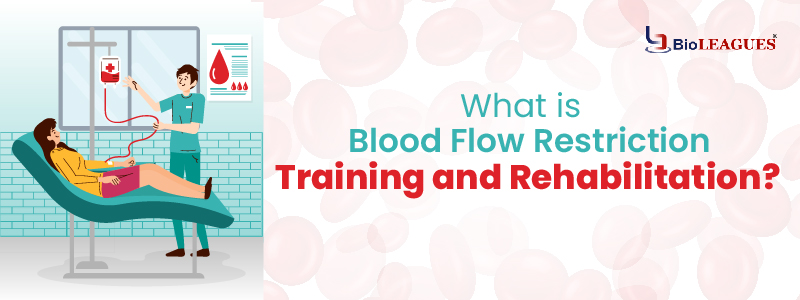Blood flow restriction (BFR) rehabilitation is an effective way to rehabilitate muscle injuries. Injuries and surgeries often weaken our muscles. So, patients are unable to perform high-resistance exercise. BFR is an effective and safest method that combines low-load resistance training with blood flow restriction rather than high-resistance muscle training.
BFR therapy can be a part of the daily fitness regime or conducted under the supervision of professionals working in rehabilitation facilities. Studies show that BFR can reduce muscle mass loss, speed up recovery, decrease bone healing time, and allow patients to enhance their muscle strength and size. So, this therapy is often used in the acute phase of rehabilitation after extremity surgeries, including hip/knee replacement, meniscectomy, and ACL reconstruction, to name a few. BFR is particularly helpful to patients suffering from rheumatoid arthritis, osteoarthritis, or osteoporosis.
Continue reading the blog to learn what BFR therapy is, how it works, and what its benefits are.
What is Blood Flow Restriction Training in Rehabilitation?
Blood flow restriction (BFR) training is exactly what it sounds like. It is a novel strengthening technique used in many conditions such as muscle weakness, degenerative among others. This technique can be used to prevent disuse atrophy resulting from bedrest by improving blood circulation. When combined with aerobic exercise, Blood Flow Restriction Training in Rehabilitation can improve cardiovascular health and help in rehabilitation.
So, BFR training can be a helpful addition to your fitness routine, especially during recovery weeks. It is also great for people with osteoporosis who cannot lift the weight required to support muscle growth.
Initially introduced in Japan in the 1960s by Dr. Yoshiaki Sato, BFR training was known as KAATSU training. It involves using a pneumatic cuff (tourniquet or elastic band) around the muscle that needs to be trained. The pneumatic cuff helps prevent the blood flow out of that particular area. Then, the cuff is inflated to a specific pneumatic compression to obtain partial vascular occlusion. The patient then does resistance exercises at a low intensity and at short rest intervals.
This type of muscle training tricks the body into thinking you are working harder than you are. So, it is a “work smarter, not harder” technique of strength training.
So, it is evident that blood flow restriction therapy stimulates muscle hypertrophy with supplemental benefits for cardiovascular health and pain management. New forms of BFR that involve the use of the latest technologies, such as robotics in rehab and gamification and rehab alike, hold promise for expedited recovery.
How Does Restrictive Blood Flow Training Work?
Strength training changes the environment inside muscles and activates muscle hypertrophy. Here is how muscle growth happens:
- Increasing muscle mass requires stressing them enough to injure muscle fibers. The amount of resistance or weight required for this varies from one person to another depending on their fitness level.Once muscles get damaged, our body starts repairing and rebuilding them, resulting in stronger and larger muscles.
- Our body demands more oxygen for weight lifting, which means less oxygen available to muscle tissues. As a result, your body creates lactic acid and stimulates muscle hypertrophy.
- Engaging in physical workouts increases blood flow, and more blood in muscles swells them, which further leads to muscle growth.
BFR training creates the same environment in muscles – flowing blood to muscles – but using less weight and lower intensity. However, the use of a tourniquet blocks the blood from flowing out through veins. This restriction allows muscles to experience fatigue, oxygen depletion, and swelling faster.
BFR makes muscles work harder.
BFR bands are placed near the upper arms and/or upper legs. These bands do not create complete occlusion of arterial blood, making it a safe therapy for most patients. Instead, they partially restrict the venous blood return. As a result, our muscles have to work harder to circulate the blood back to our heart. At the local cellular level, this causes homeostasis disturbance, as with heavy weights. During rest, the muscle cells recover, with the bands being inflated during these periods to enhance their benefits.
Brain and Changing Oxygen Levels
During BFR training, our body experiences rapid blood circulation, where oxygen flows through the circulatory system. Our central nervous system signals our brain that our limbs are not receiving enough oxygen. Please note that decreased oxygen levels are temporary and important for BFR training. In response, the brain alerts the endocrine system, which releases certain hormones into the bloodstream.
During BFR, the anterior pituitary gland in the brain releases growth hormones, encouraging muscle cell reproduction, muscle cell regeneration, and lipolysis. In addition, the release of insulin-like growth factor-1 helps with muscular hypertrophy, muscle, and bone growth.
All of this further makes rehabilitation gains at a faster rate.
Recent Developments in Blood Flow Restriction Training Rehabilitation
Robotics in Blood Flow Restriction Training
The use of robotics in rehab has taken BFRT training to the next level, offering well-controlled, more precise, and efficient rehabilitation solutions. Using robotic devices allows for a precise control of blood flow restriction applied to the target areas, resulting in consistent and optimal compression. This makes BFRT even safer, more effective, and reliable for patients with different needs.
In addition, the blend of robotics and BFRT enables personalised rehab programs. This is because robotic systems adapt the resistance levels according to the patient’s progress and maximize recovery outcomes. This technology also helps monitor the patient’s performance and physiological responses to BFRT sessions. So, their training can be adjusted to improve their condition over time.
Moreover, robotics in rehab mitigates the potential risks associated with complications resulting from improperly applied pressure during BFRT. For patients recovering from major surgeries and injuries, early mobilization is important. Robotic-assisted BFRT helps provide effective early mobilisation so that patients can regain mobility faster with less discomfort.
Telehealth in Rehab
Telehealth in Blood Flow Restriction Training
With advancing technology, telehealth in rehab has become popular when it comes to delivering services remotely. It allows patients to receive support without traveling to a clinic, so they can follow rehabilitation protocols. The technology is particularly helpful to patients taking BFR training during rehabilitation.
Telehealth also helps provide patients with real-time feedback and personalised treatment plans. It eliminates the need for frequent visits, making rehabilitation more accessible and convenient.
Virtual Reality in Blood Flow Restriction Training
Undoubtedly, BFR therapy is very powerful on its own. However, integrating this training with virtual reality in rehab can take its effectiveness to the next level. VR rehab involves creating immersive environments using VR technology. In these environments, patients feel more engaging while performing rehabilitation exercises. This increases patient adherence and motivation to the program.
The immersive nature of VR promotes cognitive and physical aspects of rehabilitation, resulting in better outcomes. So, this makes BFR training helpful to those needing cognitive stimulation alongside physical rehab.
Artificial Intelligence (AI) in Blood Flow Restriction Training
Artificial intelligence in rehab has shown many proven benefits. When combined with BFR training, the therapy becomes even more personalized and effective. AI is used to analyze data from various sensors and optimize the pressure applied to the patient. The previously discussed virtual reality in rehab is one example of AI usage in BFR training.
AI algorithms help provide customized therapy based on the patient’s specific data. Therapists can provide real-time feedback on patients’ performance and suggest improvements accordingly. In addition, AI enables continuous monitoring of patients so that pressure can be ensured at an optimal level without causing any discomfort.
Cognitive Behavioral Therapy (CBT) in Blood Flow Restriction Training
CBT in rehab is a psychological therapy that helps patients understand how feelings and thoughts influence behavior. When integrated with BFR training, CBT can be very helpful in pain management because it can help reduce anxiety about the therapy.
In addition, BFR training is beneficial to athletes and sportspeople. When combined with sports psychology and rehab strategies, BFR makes athletes experience better outcomes and faster recovery.
Hydrotherapy Rehab in Blood Flow Restriction Training
Hydrotherapy Rehab involves using water for therapeutic purposes, and it has been a part of rehabilitation for a long time. When BFR training and hydrotherapy are combined, it makes strength training and physical recovery even more effective. Hydrotherapy amplifies the benefits of BFR by leveraging water’s benefits to reduce strain and speed up healing.
The buoyancy of water minimizes pressure on joints and muscles, making it suitable for faster recovery from injury or surgery. At the same time, resistance provided by water ensures engaging multiple muscle groups without the high impact of intensive exercises. Moreover, water produces hydrostatic pressures that help reduce swelling and improve blood circulation, which can amplify BFR’s effects and accelerate recovery times.
Final Words
As you see, BFR training can be immensely beneficial in rehabilitation, particularly when recovering from serious injuries and/or surgeries. In addition, clinic management softwares for rehab can also play a significant role in optimising BFR training programs. These software systems help ensure that therapists can effectively monitor and improve the treatment based on patient records, scheduling, and progress tracking.
We can say that technology integration with BFR therapy improves the overall patient experience. It helps deliver excellent patient care and rehabilitation treatment.




